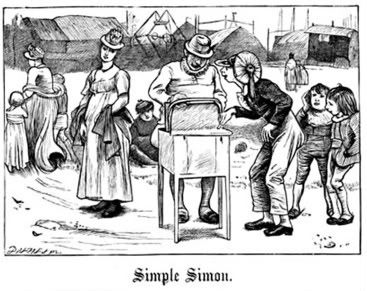
Simple Simon met a pieman going to the fair;
Said Simple Simon to the pieman, "Let me taste your ware."
Said the pieman to Simple Simon, "Show me first your penny."
Said Simple Simon to the pieman, "Sir, I have not any!
Even if you can't remember the very first pie you ever sank your teeth into, chances are very good that you can recite the most well known pie encrusted nursery rhymes with a certain flair and bravado.
Whether you favor Simple Simon, Georgie Porgie, Little Jack Horner, or Sing a Song of Sixpence, let's face it -- they all taste good rolling around in our mouths, evoking happy childhood days when we cared more about cadence than calories.
On the way to London, Horner knew this bribe was futile, so he pulled out the deed for the "plum" of all estates, Mells Manor. Whiting was accused of treason and his abbey was destroyed, but Horner moved into Mells, where his descendants lived until the 20th century (no doubt enjoying all manner of pies).
But my favorite pieful nursery rhyme is Sing a Song of Sixpence:
Sing a song of sixpence a pocketful of rye,
Four and twenty blackbirds baked in a pie.
When the pie was opened the birds began to sing,
Oh wasn't that a dainty dish to set before the king?
The king was in his counting house counting all his money,
The queen was in the parlour eating bread and honey.
The maid was in the garden hanging out the clothes,
When down came a blackbird and pecked off her nose!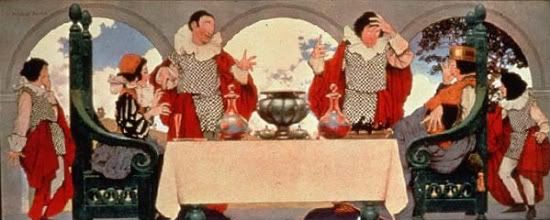
Apparently hiding living things in pie was pretty common in olden times as a form of banquet entertainment. Just when I thought live blackbirds were a pretty cool surprise, I come to find they also included other small animals, such as frogs, turtles and rabbits. The ultimate surprise, however, involved small people! Yes, diminutive individuals were hidden in pies, popping out to the delight of assembled guests, after which time they might stroll up and down the table doing tricks or reciting poetry.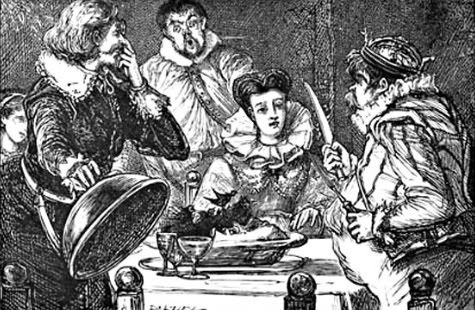
Probably the most famous of these little pie poppers was Jeffrey Hudson (1619 -1682), whose birthday is this Saturday. (Be sure to sing the birthday song in his honor, for he deserves your remembrance.)
At age seven, Jeffrey was served in a cold pie to surprise King Charles I and Queen Henrietta Maria (15 at the time) at a banquet given in their honor by the Duke and Duchess of Birmingham. Before Henrietta could cut into the pie, Jeffrey popped out, a perfectly proportioned 18" little man, dressed in a suit of miniature armour. The Duke graciously presented Jeffrey to Henrietta as a gift, since upon seeing him she was keen to add him to her collection of oddities. Jeffrey was dubbed "Lord Minimus," and became the Queen's dwarf, trusted companion and court favorite for 18 years. He was charming, delightful and even inspired several poems and narratives.
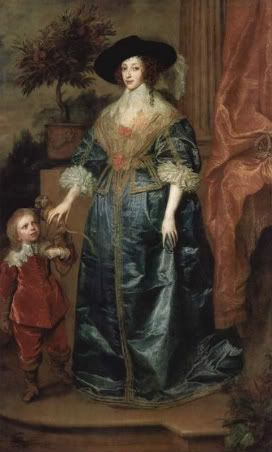
Queen Henrietta Maria with Jeffrey Hudson
by Van Dyck (1633)
National Gallery, Washington, D.C.
Apparently he didn't grow another inch until after he left court, was kidnapped by pirates twice, and descended into slavery for 25 years. I guess during this time he wasn't called upon to hide in any more pies, so he allowed himself to grow another 45 inches. Though Simon's rhyme is more well-known, I vote for Jeffrey Hudson as the ultimate pieman!
So, my friends, if your cherry is the pits, your custard won't pass muster, and, God help you, your pecan has everyone positively peeved, consider prebaking a double crust, and then filling it with one or two of your shorter friends. This will guarantee your stature as an uber hostess, and no one will ever call you flaky.
Seconds and thirds: If you're in a crafty mood, try making your own blackbird pie out of construction paper and a few art supplies.
If you're in a crafty mood, try making your own blackbird pie out of construction paper and a few art supplies. Order this cute blackbird pie print by Debbi Hubs.
Order this cute blackbird pie print by Debbi Hubs. If you're in the mood to let off a little steam, get a ceramic pie bird.
If you're in the mood to let off a little steam, get a ceramic pie bird. Best of all, for some musical pie, watch Nina Mae McKinney and the Nicholas Brothers in this fabulous old time soundie, "Pie Pie Blackbirds," circa 1932! Sure to get your feet a tappin' . . .
Best of all, for some musical pie, watch Nina Mae McKinney and the Nicholas Brothers in this fabulous old time soundie, "Pie Pie Blackbirds," circa 1932! Sure to get your feet a tappin' . . .
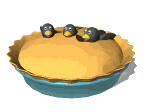
(Thanks to Linda Stradley, "The History of Pie," What's Cooking America, 2004.)
Viewing: Blog Posts Tagged with: pie nursery rhymes, Most Recent at Top [Help]
Results 1 - 2 of 2
Blog: jama rattigan's alphabet soup (Login to Add to MyJacketFlap)
JacketFlap tags: pie month, jeffrey hudson, pie nursery rhymes, Add a tag
Blog: Born to Write (Login to Add to MyJacketFlap)
JacketFlap tags: john steinbeck, the ghost of tom joad, grapes of wrath, music, writing, bruce springsteen, bruce springsteen, john steinbeck, the ghost of tom joad, grapes of wrath, Add a tag
This is what happens after 1: overdosing on two drinks, linguini with white clam sauce, and a Veal Francaise at the The Park Side Restaurant in Queens, where tuxedos and GODFATHER-types meet, 2: a sinus headache, 3: a snoring husband ruining any chances of a good night's sleep and 4: the curse of having a television in your bedroom and a remote control to keep you company, jumping from channel to channel until your eyes rest upon a 4 AM showing of THE GRAPES OF WRATH and you know you're not going anywhere until the credits roll.
I think, therefore I write.
You have anything better for me to do with my time in the middle of the night?
Don't answer that unless your thoughts are PG-rated. ;>
And hell if I didn't think so hard that I turned to keyboard and screen. Damn you, wretched and tempest-tossed writers. Can never keep these things to yourselves, can you? ;>
Great Characters Make Great Stories. These are the books we remember. The characters that transcend the page. The iconic voices we carry with us, speaking to us from beyond the confines of the novel and remind us, time and again, why literature is a powerful link between generations. These are the voices that inspire me to write. To paint words into life, to connect reader to reader, to be "a little piece of a big soul." Not just for today but for tomorrow.![]() citycatinwindow introduced me to ARTISTS FOR LITERACY, an organization that promotes music inspired by great characters and great literature. Their mission is to make literature more accessible, to marry music and the written word in order to "open doors" to a more critical analysis of a book that might otherwise be daunting to a young reader.
citycatinwindow introduced me to ARTISTS FOR LITERACY, an organization that promotes music inspired by great characters and great literature. Their mission is to make literature more accessible, to marry music and the written word in order to "open doors" to a more critical analysis of a book that might otherwise be daunting to a young reader.
TOM JOAD from John Steinbeck's GRAPES OF WRATH stands tall in my pantheon of literary heroic characters. His "I'll be there" soliloquy has moved many to tears, to action-- and to music. I know. Woody Guthrie was right there, compelled to create a homage to Tom Joad after Guthrie saw the movie, THE GRAPES OF WRATH. Fast forward to another great writer who found truth and beauty in this quintessential American literary hero. Enter Bruce Springsteen. (Ah, there's always a tie that binds my words to Mr. Springsteen.)
It may not be the first question I ever ask should I have the chance to have a one-on-one moment with my muse (and, should that day ever come, I highly doubt any intelligible sounds would make it past my quivering lips), but this writer would love to ask that writer what about Steinbeck's Joad inspired him to paint his musical portrait of the Joad character in Bruce's GHOST OF TOM JOAD. Steinbeck's novel identifies a cultural war that is seeped in the soul of the American dream. After stuttering and stammering for 23 minutes in Bruce's face, telling him what hismusic has meant to me (everything), oh how I would love to ask him: "How do you see your music as a source of characters questioning what is wrong and what is right in America? Who are your characters speaking to? The choir or the disenfranchised- the believers or the estranged and alienated? Are your characters uniquely American and why? Would you rather sing to the church or a confused, wandering congregation?"
I suspect this would be his answer:
Then I would fall faint to the floor.
And... end scene!
Speaking of Page Turners: Here's to 2008-- and to you and your characters and the life you give them. (Or is it the other way around?)


